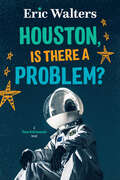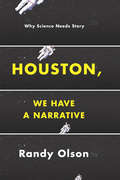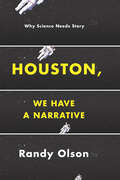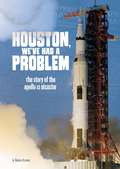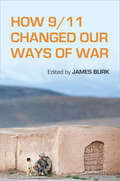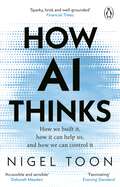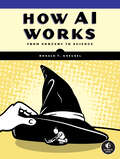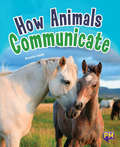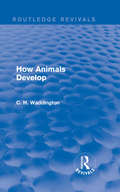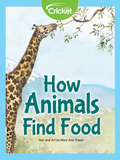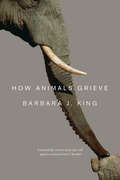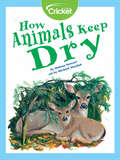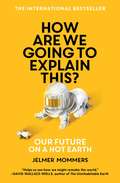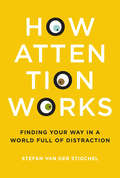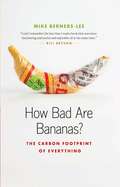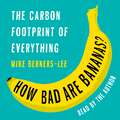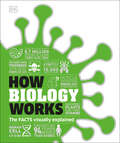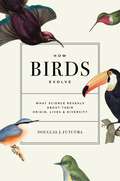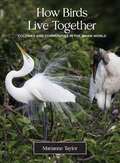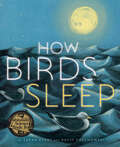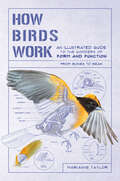- Table View
- List View
Houston, Is There A Problem?: Teen Astronauts #1 (Teen Astronauts #1)
by Eric WaltersKey Selling Points A young teen earns a scholarship to go to space camp. The first in the Teen Astronauts series featuring Houston at space camp. Examines themes of perseverance, leadership and growth mindset. This is an adventure story with an exciting setting: astronaut training camp. Eric Walters is very well known to librarians and booksellers.
Houston, We Have a Narrative: Why Science Needs Story
by Randy OlsonAsk a scientist about Hollywood, and you'll probably get eye rolls. But ask someone in Hollywood about science, and they'll see dollar signs: moviemakers know that science can be the source of great stories, with all the drama and action that blockbusters require. That's a huge mistake, says Randy Olson: Hollywood has a lot to teach scientists about how to tell a story--and, ultimately, how to do science better. With Houston, We Have a Narrative, he lays out a stunningly simple method for turning the dull into the dramatic. Drawing on his unique background, which saw him leave his job as a working scientist to launch a career as a filmmaker, Olson first diagnoses the problem: When scientists tell us about their work, they pile one moment and one detail atop another moment and another detail--a stultifying procession of "and, and, and. " What we need instead is an understanding of the basic elements of story, the narrative structures that our brains are all but hardwired to look for--which Olson boils down, brilliantly, to "And, But, Therefore," or ABT. At a stroke, the ABT approach introduces momentum ("And"), conflict ("But"), and resolution ("Therefore")--the fundamental building blocks of story. As Olson has shown by leading countless workshops worldwide, when scientists' eyes are opened to ABT, the effect is staggering: suddenly, they're not just talking about their work--they're telling stories about it. And audiences are captivated. Written with an uncommon verve and enthusiasm, and built on principles that are applicable to fields far beyond science, Houston, We Have a Narrative has the power to transform the way science is understood and appreciated, and ultimately how it's done.
Houston, We Have a Narrative: Why Science Needs Story
by Randy OlsonAsk a scientist about Hollywood, and you’ll probably get eye rolls. But ask someone in Hollywood about science, and they’ll see dollar signs: moviemakers know that science can be the source of great stories, with all the drama and action that blockbusters require. That’s a huge mistake, says Randy Olson: Hollywood has a lot to teach scientists about how to tell a story—and, ultimately, how to do science better. With Houston, We Have a Narrative, he lays out a stunningly simple method for turning the dull into the dramatic. Drawing on his unique background, which saw him leave his job as a working scientist to launch a career as a filmmaker, Olson first diagnoses the problem: When scientists tell us about their work, they pile one moment and one detail atop another moment and another detail—a stultifying procession of “and, and, and.” What we need instead is an understanding of the basic elements of story, the narrative structures that our brains are all but hardwired to look for—which Olson boils down, brilliantly, to “And, But, Therefore,” or ABT. At a stroke, the ABT approach introduces momentum (“And”), conflict (“But”), and resolution (“Therefore”)—the fundamental building blocks of story. As Olson has shown by leading countless workshops worldwide, when scientists’ eyes are opened to ABT, the effect is staggering: suddenly, they’re not just talking about their work—they’re telling stories about it. And audiences are captivated. Written with an uncommon verve and enthusiasm, and built on principles that are applicable to fields far beyond science, Houston, We Have a Narrative has the power to transform the way science is understood and appreciated, and ultimately how it’s done.
Houston, We've Had a Problem: The Story of the Apollo 13 Disaster (Tangled History)
by Rebecca RissmanIn an immersive, exciting narrative nonfiction format, this powerful book follows a selection of people who experienced the events surrounding the Apollo 13 disaster.
How 9/11 Changed Our Ways of War
by James BurkFollowing the 9/11 attacks, a war against al Qaeda by the U. S. and its liberal democratic allies was next to inevitable. But what kind of war would it be, how would it be fought, for how long, and what would it cost in lives and money? None of this was known at the time. What came to be known was that the old ways of war must changeOCobut how? Now, with over a decade of political decision-making and warfighting to analyze, "How 9/11 Changed Our Ways of War" addresses that question. In particular it assesses how well those ways of war, adapted to fight terrorism, affect our military capacity to protect "and" sustain liberal democratic values. The book pursues three themes: what shaped the strategic choice to go to war; what force was used to wage the war; and what resources were needed to carry on the fight? In each case, military effectiveness required new and strict limits on the justification, use, and support of force. How to identify and observe these limits is a matter debated by the various contributors. Their debate raises questions about waging future warsOCoincluding how to defend against and control the use of drones, cyber warfare, and targeted assassinations. The contributors include historians, political scientists, and sociologists; both academics and practitioners. "
How A Seed Grows
by Helene J. JordanHow does a tiny acorn grow into an enormous oak tree? With beautiful and accurate watercolor illustrations from Loretta Krupinski, this book by Helene Jordan traces the process of how a little seed grows into the plants and trees that surround us.
How AI Thinks: How we built it, how it can help us, and how we can control it
by Nigel ToonTHE #2 TIMES BESTSELLER'Artificial intelligence is going to have a massive impact on everyone’s lives... an accessible and sensible read that helps demystify AI' Deborah Meaden, entrepreneur and star of Dragon's Den'Nigel Toon is a visionary leader in the field of artificial intelligence... a must-read' Marc Tremblay, Distinguished Engineer, MicrosoftThose who understand how AI thinks are about to win big.We are used to thinking of computers as being a step up from calculators - very good at storing information, and maybe even at playing a logical game like chess. But up to now they haven't been able to think in ways that are intuitive, or respond to questions as a human might. All that has changed, dramatically, in the past few years.Our search engines are becoming answer engines. Artificial intelligence is already revolutionising sectors from education to healthcare to the creative arts. But how does an AI understand sentiment or context? How does it play and win games that have an almost infinite number of moves? And how can we work with AI to produce insights and innovations that are beyond human capacity, from writing code in an instant to unfolding the elaborate 3D puzzles of proteins?We stand at the brink of a historic change that will disrupt society and at the same time create enormous opportunities for those who understand how AI thinks. Nigel Toon shows how we train AI to train itself, so that it can paint images that have never existed before or converse in any language. In doing so he reveals the strange and fascinating ways that humans think, too, as we learn how to live in a world shared by machine intelligences of our own creation.
How AI Works: From Sorcery to Science
by Ronald T. KneuselAI isn&’t magic. How AI Works demystifies the explosion of artificial intelligence by explaining—without a single mathematical equation—what happened, when it happened, why it happened, how it happened, and what AI is actually doing "under the hood."Artificial intelligence is everywhere—from self-driving cars, to image generation from text, to the unexpected power of language systems like ChatGPT—yet few people seem to know how it all really works. How AI Works unravels the mysteries of artificial intelligence, without the complex math and unnecessary jargon.You&’ll learn: The relationship between artificial intelligence, machine learning, and deep learningThe history behind AI and why the artificial intelligence revolution is happening nowHow decades of work in symbolic AI failed and opened the door for the emergence of neural networksWhat neural networks are, how they are trained, and why all the wonder of modern AI boils down to a simple, repeated unit that knows how to multiply input numbers to produce an output number.The implications of large language models, like ChatGPT and Bard, on our society—nothing will be the same againAI isn&’t magic. If you&’ve ever wondered how it works, what it can do, or why there&’s so much hype, How AI Works will teach you everything you want to know.
How Animal Babies Stay Safe (Let's-Read-and-Find-Out Science 1)
by Mary Ann FraserRead and find out about how animal parents keep their babies safe from predators in this colorfully illustrated nonfiction picture book.This is a clear and appealing science book for early elementary age kids, both at home and in the classroom. It looks at the many strategies animal babies use to survive in a dangerous world. Some babies hide in nests or dens, some ride on thier parents' back or in their pouches, some use camouflage, and some rely on their parents' sharp claws and teeth to fend off enemies. Whether showing "a mother monkey swinging through the jungle with her baby on her back or two baby raccoons peeking out of their tree-house home while their mother lures a bobcat away from her young," wrote Kirkus, this book captures the eternal appeal of baby animals.It's a Level 1 Let's-Read-and-Find-Out, which means the book explores introductory concepts perfect for children in the primary grades. The 100+ titles in this leading nonfiction series are:hands-on and visualacclaimed and trustedgreat for classroomsTop 10 reasons to love LRFOs:Entertain and educate at the same timeHave appealing, child-centered topicsDevelopmentally appropriate for emerging readersFocused; answering questions instead of using survey approachEmploy engaging picture book quality illustrationsUse simple charts and graphics to improve visual literacy skillsFeature hands-on activities to engage young scientistsMeet national science education standardsWritten/illustrated by award-winning authors/illustrators & vetted by an expert in the fieldOver 130 titles in print, meeting a wide range of kids' scientific interestsBooks in this series support the Common Core Learning Standards, Next Generation Science Standards, and the Science, Technology, Engineering, and Math (STEM) standards. Let's-Read-and-Find-Out is the winner of the American Association for the Advancement of Science/Subaru Science Books & Films Prize for Outstanding Science Series.
How Animals Communicate (Into Reading, Level T #53)
by Annette SmithNIMAC-sourced textbook <p><p> Did you know that, like people, animals communicate with each other? When animals send and receive messages using smell, sight, sound, and touch, they're not just saying 'hi'—communication is vital to their survival!
How Animals Develop: A Short Account Of The Science Of Embryology - Primary Source Edition (Routledge Revivals: Selected Works of C. H. Waddington)
by C. H. WaddingtonFirst published in 1935 (this edition in 1946), this short account of the science of embryology was the first book in English to provide a simple outline of the whole of this important subject. The study of development is perhaps the best method of approach to the most fundamental of all biological problems, the problem of how all the diverse activities are integrated so as to make up a complete individual organism. The book gives a short sketch of the general pattern on which all animals are built, but devotes more attention to the factors which cause the development of the elements in the pattern, and which then bring them into correct relations with one another. This volume is simply written in order to enable the general reader to understand the revolutionary advances made in the subject at that time.
How Animals Find Food
by Mary Ann FraserAnimals get their energy from the food they eat. Animals depend on other living things for food. Some animals, called herbivores, eat plants; while others are carnivores that eat other animals. Scavengers, like vultures and hyenas, eat dead animals. Learn how different animals eat and how this determines how they look and where they live. Can you name other animals that are scavengers?
How Animals Grieve
by Barbara J. KingFrom the time of our earliest childhood encounters with animals, we casually ascribe familiar emotions to them. But scientists have long cautioned against such anthropomorphizing, arguing that it limits our ability to truly comprehend the lives of other creatures. Recently, however, things have begun to shift in the other direction, and anthropologist Barbara J. King is at the forefront of that movement, arguing strenuously that we can and "should" attend to animal emotions. With "How Animals Grieve," she draws our attention to the specific case of grief, and relates story after story from fieldsites, farms, homes, and more of animals mourning lost companions, mates, or friends. King tells of elephants surrounding their matriarch as she weakens and dies, and, in the following days, attending to her corpse as if holding a vigil. A housecat loses her sister, from whom she's never before been parted, and spends weeks pacing the apartment, wailing plaintively. A baboon loses her daughter to a predator and sinks into grief. In each case, King uses her anthropological training to interpret and try to explain what we see to help us understand this animal grief properly, as something neither the same as nor wholly different from the human experience of loss. The resulting book is both daring and down-to-earth, strikingly ambitious even as it is careful to acknowledge the limits of our understanding. Through the moving stories she chronicles and analyzes so beautifully, King brings us closer to the animals with whom we share a planet, and helps us see our own experiences, attachments, and emotions as part of a larger web of life, death, love, and loss.
How Animals Keep Dry
by Melissa StewartMany animals take cover when it rains. They like to stay warm and dry too!
How Are We Going to Explain This?: Our Future on a Hot Earth
by Jelmer MommersThere&’s a new story in the making, one in which the consequences of our actions add up—and every contribution is meaningful.If climate change is the biggest threat humanity has ever faced, then why are we doing so little about it? And where do we go from here? Journalist Jelmer Mommers knows most people prefer not to talk or even think about climate change, and that is exactly why he wrote this book. Denial and despair are not the only possible responses to the current crisis. Drawing on the latest science, Mommers describes how we got here, what possible future awaits us, and how you can help make a difference. Five years in the making, How Are We Going to Explain This was an instant bestseller in the Netherlands. With this revised and updated translation, including responses to the COVID-19 pandemic, Mommers brings his unique blend of realism and hope to the wider world.
How Attention Works: Finding Your Way in a World Full of Distraction (The\mit Press Ser.)
by Stefan Van Der StigchelHow we filter out what is irrelevant so we can focus on what we need to know.We are surrounded by a world rich with visual information, but we pay attention to very little of it, filtering out what is irrelevant so we can focus on what we think we need to know. Advertisers, web designers, and other “attention architects” try hard to get our attention, promoting products with videos on huge outdoor screens, adding flashing banners to websites, and developing computer programs with blinking icons that tempt us to click. Often they succeed in distracting us from what we are supposed to be doing. In How Attention Works, Stefan Van der Stigchel explains the process of attention and what the implications are for our everyday lives.The visual attention system is efficient, Van der Stigchel writes, because it doesn't waste energy processing every scrap of visual data it receives; it gathers only relevant information. We focus on one snippet of information and assume that everything else is stable and consistent with past experience; that's why most people miss even the most glaring continuity errors in films. If an object doesn't meet our expectations, chances are we won't see it. Van der Stigchel makes his case with examples from real life, explaining, among other things, the limitations of color perception (and why fire trucks shouldn't be red); the importance of location (security guards and radiologists, for example, have to know where to look); the attention-getting properties of faces and spiders; what we can learn from someone else's eye movements; why we see what we expect to see (magicians take advantage of this); and visual neglect and unattended information.
How Authors' Minds Make Stories
by Patrick Colm HoganThis book explores how the creations of great authors result from the same operations as our everyday counterfactual and hypothetical imaginations, which cognitive scientists refer to as "simulations. " Drawing on detailed literary analyses as well as recent research in neuroscience and related fields, Patrick Colm Hogan develops a rigorous theory of the principles governing simulation that goes beyond any existing framework. He examines the functions and mechanisms of narrative imagination, with particular attention to the role of theory of mind, and relates this analysis to narrative universals. In the course of this theoretical discussion, Hogan explores works by Austen, Faulkner, Shakespeare, Racine, Brecht, Kafka, and Calvino. He pays particular attention to the principles and parameters defining an author's narrative idiolect, examining the cognitive and emotional continuities that span an individual author's body of work.
How Bad Are Bananas?
by Mike Berners-LeePart green-lifestyle guide, part popular science, How Bad Are Bananas? is the first book to provide the information we need to make carbon-savvy purchases and informed lifestyle choices and to build carbon considerations into our everyday thinking.The book puts our decisions into perspective with entries for the big things (the World Cup, volcanic eruptions, the Iraq war) as well as the small (email, ironing, a glass of beer). And it covers the range from birth (the carbon footprint of having a child) to death (the carbon impact of cremation).Packed full of surprises - a plastic bag has the smallest footprint of any item listed, while a block of cheese is bad news - the book continuously informs, delights, and engages the reader. Solidly researched and referenced, the easily digestible figures, statistics, charts, and graphs (including a section on the carbon footprint of various foods) will encourage discussion and help people to make up their own minds about their consumer choices.
How Bad Are Bananas?: The carbon footprint of everything
by Mike Berners-LeeHow Bad Are Bananas? was a groundbreaking book when first published in 2009, when most of us were hearing the phrase 'carbon footprint' for the first time. Mike Berners-Lee set out to inform us what was important (aviation, heating, swimming pools) and what made very little difference (bananas, naturally packaged, are good!).This new edition updates all the figures (from data centres to hosting a World Cup) and introduces many areas that have become a regular part of modern life - Twitter, the Cloud, Bitcoin, electric bikes and cars, even space tourism. Berners-Lee runs a considered eye over each area and gives us the figures to manage and reduce our own carbon footprint, as well as to lobby our companies, businesses and government. His findings, presented in clear and even entertaining prose, are often surprising. And they are essential if we are to address climate change.
How Biology Works: The Facts Visually Explained (DK How Stuff Works)
by DKDiscover everything you need to know about biology, with the simplest most visual guide to the science of life.How do vaccines work? What is special about stem cells? How did we evolve from bacteria? The science of life can be dauntingly complex, and it can be hard to separate &“good&” science from &“bad&”, fundamental truths from the much-hyped breakthroughs reported in the media. With clear, easy-to-understand graphics and packed with fascinating facts, How Biology Works demystifies both the core biology that may have eluded us at school, and the cutting-edge life science that makes the news, answering the questions that spark our curiosity.With power to every page, this striking science book:- Is illustrated entirely by specially commissioned, boldly-colored, distinctive, flat, vector graphics that explain each topic clearly and engagingly.- Uses clear, distinctive, eye-catching graphics to make even complex biology easy to understand.- Offers a practical, no-nonsense approach to each subject.Building from life&’s fundamental ingredients, such as carbon and water, the book explains chemical processes in living cells, controlled by the ultimate biochemical, DNA. It shows how DNA is made of units called genes, which are shuffled in each generation of offspring, leading to variation and evolution. It covers topics from school biology, such as how plants work and how animals, including humans, work, and goes on to ecology and biotechnology. Beyond school science, however, it covers the background to the latest medical technology and biotechnology: how gene therapy works, what stem-cell research is achieving, and how our immune systems, boosted by vaccines, are in an arms race with ever-mutating viruses and other pathogens.At DK, we believe in the power of discovery.So why stop there?How Biology Works is part of DK's widely successful How Stuff Works series. Discover the inner workings of the mind with How the Brain Works, succeed in all things science with How Science Works and discover the cosmos like you've never known before with How Space Works. Whatever topic sparks your interests, there's a plethora of knowledge to discover!
How Birds Evolve: What Science Reveals about Their Origin, Lives, and Diversity
by Douglas J. FutuymaA marvelous journey into the world of bird evolutionHow Birds Evolve explores how evolution has shaped the distinctive characteristics and behaviors we observe in birds today. Douglas Futuyma describes how evolutionary science illuminates the wonders of birds, ranging over topics such as the meaning and origin of species, the evolutionary history of bird diversity, and the evolution of avian reproductive behaviors, plumage ornaments, and social behaviors.In this multifaceted book, Futuyma examines how birds evolved from nonavian dinosaurs and reveals what we can learn from the "family tree" of birds. He looks at the ways natural selection enables different forms of the same species to persist, and discusses how adaptation by natural selection accounts for the diverse life histories of birds and the rich variety of avian parenting styles, mating displays, and cooperative behaviors. He explains why some parts of the planet have so many more species than others, and asks what an evolutionary perspective brings to urgent questions about bird extinction and habitat destruction. Along the way, Futuyma provides an insider's perspective on how biologists practice evolutionary science, from studying the fossil record to comparing DNA sequences among and within species.A must-read for bird enthusiasts and curious naturalists, How Birds Evolve shows how evolutionary biology helps us better understand birds and their natural history, and how the study of birds has informed all aspects of evolutionary science since the time of Darwin.
How Birds Live Together: Colonies and Communities in the Avian World
by Marianne TaylorA beautifully illustrated exploration of the ways birds cohabitFeaturing dramatic and delightful wild bird colonies and communities, How Birds Live Together offers a broad overview of social living in the avian world. From long-established seabird colonies that use the same cliffs for generations to the fast-shifting dynamics of flock formation, leading wildlife writer Marianne Taylor explores the different ways birds choose to dwell together.Through fascinating text, color photos, maps, and other graphics, Taylor examines the advantages of avian sociality and social breeding. Chapters provide detailed information on diverse types of bird colonies, including those species that construct single-family nests close together in trees; those that share large, communal nests housing multiple families; those that nest in tunnels dug into the earth; those that form exposed colonies on open ground and defend them collectively, relying on ferocious aggression; those that live communally on human-made structures in towns and cities; and more. Taylor discusses the challenges, benefits, hazards, and social dynamics of each style of living, and features a wealth of species as examples.Showcasing colonies from the edge of Scotland and the tropical delta of the Everglades to the Namib Desert in Africa, How Birds Live Together gives bird enthusiasts a vivid understanding of avian social communities.
How Birds Sleep
by David ObuchowskiDiscover the mysterious and fascinating sleeping habits of more than twenty bird species from around the world in this gorgeously illustrated read-aloud picture book, perfect for bedtime, or any time.Have you ever seen a bird sleep? Or wondered just when it is that migrating cranes find the time to catch Z&’s as they cross the ocean? From the parrots of Thailand to the ostriches of Australia and even the pigeons of New York City, every bird sleeps—but they do it in ways that will surprise and delight you. Some hang from tree branches, others doze while gliding, and some even burrow underground for a nap. Written in a witty, conversational voice, and with gorgeous illustrations, this picture book is bursting with interesting facts about this underexplored aspect of bird life all around us.
How Birds Work: An Illustrated Guide To The Wonders Of Form And Function--from Bones To Beak (How Nature Works #0)
by Marianne TaylorEngineered by evolution to thrive in the wild A tiny textbook to learn on your own How Birds Work goes beyond the typical field guide to show us not only what birds look like but why. Why do many owls have asymmetrical ear openings? (Hint: It helps them pinpoint prey; see page 40.) And why does the Grey Heron rest on one leg at a time? (Hint: Not because it’s tired; see page 66!) Birds boast a spectacular array of adaptations suited to their incredibly diverse diets and habitats. In this in-depth handbook, discover the ways they’re even more astounding than you know—inside and out. Detailed analysis and illustrations illuminate: Skeleton Muscles Circulation Digestion Respiration Reproduction Feathers Colors and Patterns And much, much more!
